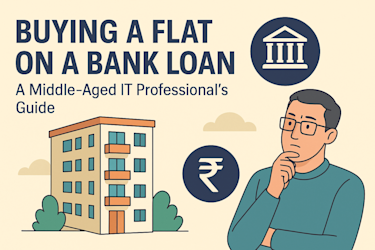
Buying a Flat on a Bank Loan: A Middle-Aged IT Professional’s Guide
Posted on August 13, 2025
If you’re in your 40s or early 50s, earning a stable IT salary, the thought of owning your own flat can feel both exciting and nerve-wracking. The comfort of stability meets the reality of long-term financial commitments. Let’s break down what you should consider before signing that home loan agreement.
Key Things to Consider Before Taking the Plunge
1. Your Loan Tenure vs. Your Retirement Age
Why it matters: Most banks offer home loans up to 30 years, but will reduce tenure if you’re nearing retirement.
If you’re 45 and taking a 20-year loan, you’ll still be paying EMIs into your mid-60s — post-retirement cash flow could be tight.
Tip: Aim for the shortest possible tenure you can comfortably afford.
2. EMI Affordability and Job Stability
Banks typically cap your EMI at 40–50% of net monthly income.
IT sector is stable, but not immune to layoffs or project changes.
Tip: Keep EMI + other debts under 35% of take-home pay for flexibility.
3. Interest Rate Type
Floating rate: Lower initially, but may rise in future.
Fixed rate: Predictable payments, but higher than current floating rates.
Tip: For long tenures, floating rates often work better — but keep a rate-hike buffer in your budget.
4. Location and Appreciation Potential
Middle age means you may not want to gamble on “emerging” areas with uncertain growth.
Tip: Focus on well-connected, livable areas with established infrastructure, even if the price per sq. ft. is higher.
5. Maintenance Costs
Modern flats have high monthly maintenance charges (security, lifts, clubhouse).
Tip: Factor in maintenance as a fixed post-purchase expense — it’s like a second EMI over decades.
6. Insurance Cover
If something happens to you, you don’t want your family to be burdened with EMIs.
Tip: Take a term life insurance policy equal to the loan amount.
7. Tax Benefits
Section 24(b): Up to ₹2 lakh deduction on interest annually.
Section 80C: Principal repayment up to ₹1.5 lakh included (shared with other 80C investments).
Tip: Tax savings help, but don’t buy only for deductions — they are just a sweetener.
Pros of Buying a Flat on a Loan at This Stage
✅ Asset Creation – You build an asset that can be used, rented, or sold. ✅ Tax Benefits – Home loan deductions can reduce taxable income. ✅ Stability – No rent, predictable EMIs (especially if fixed rate). ✅ Leverage – Using the bank’s money lets you own a property sooner rather than later.
Cons and Risks
❌ Long-Term Debt into Retirement – Risky if you can’t keep up after salary stops. ❌ Interest Burden – Over decades, you may pay almost as much in interest as the flat’s price. ❌ Liquidity Lock-In – Hard to sell quickly if you need cash. ❌ Job Market Volatility – Any income disruption could strain EMI payments. ❌ Hidden Costs – Registration, stamp duty, society fees, repairs — all add up.
Other Options to Consider
1. Shorter Tenure + Higher EMI
Pay off before retirement to enjoy a debt-free retirement.
Use bonuses and salary hikes to make part-prepayments.
2. Rent Instead of Buying
Flexibility to move for projects or better opportunities.
Invest the difference in mutual funds or retirement plans — sometimes yields better returns than property appreciation.
3. Buy a Smaller Flat
Lower loan amount = lower EMI + shorter tenure.
Easier to maintain.
4. Joint Loan with Spouse
Higher combined eligibility.
But be mindful: both incomes are tied to EMI commitment.
Final Thought
For a middle-aged IT employee, buying a flat on a bank loan is less about chasing appreciation and more about securing a comfortable home without jeopardizing retirement. The key is to plan your EMIs around your post-retirement life, not just your current salary.
A home can be your comfort zone — but only if it doesn’t become your financial cage.